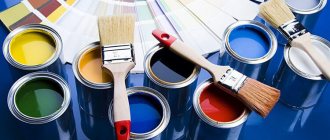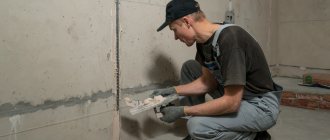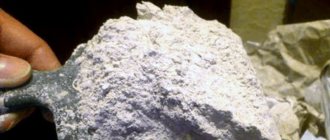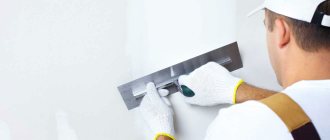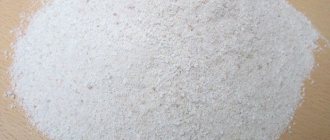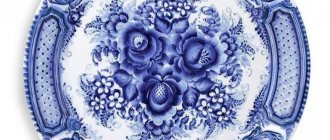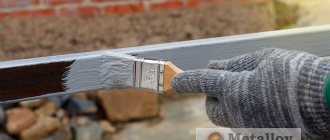The use of paint for walls has always been relevant. Incredible design solutions are implemented in apartments with its help. Paint is used to create drawings, patterns, and solid fills. In many apartments it is used as an analogue to boring wallpaper.
There is a common belief that rooms whose walls are painted are unsafe to live in. This article discusses options for environmentally friendly materials that are safe for health. You will learn how to choose the best white paint for painting walls or ceilings.
The range of paint in stores is quite wide: for exterior and interior painting, for painting metal parts, wood, concrete, brick. There is also white facade paint.
Why do you need white paint?
White shades in design are a universal color. It always fits any material, style. It is ideal for interior and exterior painting.
This light color symbolizes purity and creates a cozy atmosphere. White color has many shades - beige, baked milk color, shades of cotton, bright pearlescent, and also different colors have different textures. With proper combination and selection, such a solution will not look boring or monotonous.
White colors go with all shades. You can often see white facades of houses. White paint is the most popular, so there are a huge number of its types.
4. Condition and texture of the wall: how to prepare them before starting?
The walls of modern houses, as well as old walls damaged by time, may have small and large cracks. They must be leveled. After all, on a white (light) background, all painting flaws are visible especially clearly. For a high-quality result, not only uniform painting, but also a uniform surface is important.
Small (narrow) recesses are covered with spatula (putty) using a thin spatula. The mass should be packed as deeply as possible to prevent further cracking.
Large cracks must be prepared before filling. To do this, their edges are slightly widened by scraping them off with a hammer and chisel. This improves the adhesion of the putty to the wall and large pieces of this corrective mass will not fall out of the wall later.
In the most difficult cases, when the wall is hopelessly uneven, it is covered with plasterboard panels, which are then painted white. You can also use non-woven wallpaper as a base. They can hide minor roughness and make it possible to paste wallpaper as a second layer.
Acrylic
Acrylic paint is suitable for wood. Matte acrylic paint is suitable for walls and ceilings. Convenient and profitable option. White acrylic paint has many advantages:
- Price. These are the most affordable paints.
- Practicality. The paint is resistant to temperature changes and has a long shelf life and operation. The paint is not afraid of precipitation and even strong winds.
- Fast drying paint.
- Strength. A protective layer is formed on the painted surface, which protects the wall or ceiling from mechanical damage.
- Moisture resistance. It is due to this that the paint is ideal for working with wood.
- Mixing. Acrylic paint easily mixes with paints of other compositions, thanks to this you can create any desired shade.
- Sun resistance. Thanks to its chemical structure, the paint does not crack. It also does not lose its shade in the light of the sun.
3. Living Room: Strong White by Farrow & Ball
Farrow and ball
According to Caroline Grant and Dolores Suarez of Dekar Design, Strong White is the ideal neutral white paint color. “It doesn't have pink or yellow undertones, but it has the softness needed for a true white. When people think of white, they think Sterile White looks sick, and Strong White looks soft and deep.”
Alkyd
Alkyd paint is a mixture of varnishes. It itself is thick because the mixture contains heavy resins and oils. The paint is used only after mixing in a solvent. The paint dries for 3 days, after which it does not fade. Suitable for indoor and outdoor use.
Alkyd paints have the following advantages:
- Moisture resistance.
- Pre-globality.
- Low cost.
- Protection of coated surfaces from rotting.
- Does not collapse even under severe impacts.
Classification
White paint is used for interior and exterior work. Modern manufacturers produce the following types;
- Acrylic;
- Alkyd;
- Water-dispersed;
- Polyurethane;
- Oily.
Let's briefly look at the main types of white paint. This will help you choose the right paint and varnish that is needed for specific work.
Oily
Inorganic insoluble flour is used as a coloring agent in oil paints. When not used for a long time, this pigment settles to the bottom. Oil paint is obtained by mixing drying oil and meat base.
Important: white oil paint does not exist. There are only its darker shades.
It is well suited for interior decoration. The most important advantage of oil paint is its low consumption. However, it has an important drawback - lack of permeability. The paint is not suitable for painting the facade.
Rating of the best paints for walls
In many ways, the choice of one type of paint or another depends on the operating conditions of the surfaces in the room where the walls are to be painted, the microclimate in it, as well as the material of the walls. The highest load on the wall material occurs in the kitchen. This is due to increased humidity, moisture, grease, hot steam, and other contaminants on the walls. Therefore, it is better to choose latex or silicone paint here. Acrylic compositions can be chosen for living rooms and bedrooms. To paint the walls in a nursery, it is better to choose a composition that has the appropriate mark on the packaging.
Water-dispersed
These are paints based on a solution in water. It is the most environmentally friendly and safe. Dyspepsia is a mixture of solids in one liquid solution. This paint looks like a paste. Before coating, this paint must be dissolved in water.
Water-dispersed paints have a number of advantages:
- High level of security.
- No smells.
- Fire resistance, fire protection.
- Easy to use.
- High permeability.
- 15 years of paint shelf life.
- Resistant to any damage.
- Budget price.
Paint selection criteria
repaint the walls
Choose thick paint, especially if you take on the task of painting a dark wall snow-white. On store shelves there are products with different levels of coverage - from high to low, with lower or higher costs. Price in this case should not be a factor determining the choice, because often the cheaper paint is the least economical.
It will require the application of several additional layers and, thus, will require more time and the repair will be delayed. This doesn't mean you have to find the most expensive paint. The most important criterion is quality!
To choose the right paint, it is best to analyze the information on the label. The label contains detailed information about its purpose, type of substrate, coating. It indicates the drying time and productivity, which determine the size of the surface that can be painted over with one liter of product.
In addition to them, it is worth paying attention to whether the paint has expired. This can greatly limit its effectiveness. It is also worth familiarizing yourself with the manufacturer's recommendations, for example regarding paint thinning. If they are not there, do not experiment and do not look for savings, because the effect may be counterproductive.
Photo of white paint
Quick-drying, odorless paint for interior work - main types, selection tips and benefits of useThe best aerosol paint in cans - main types, application features and advantages of use
The best water-based paint - ranking of the best manufacturers of 2018
How to choose façade paint for exterior use - a review of popular manufacturers and a rating of the best paints for exterior useWhich oil paint is better - a review of the best brands and criteria for selecting paints
The best interior paint for walls - 2021 rating and instructions for using interior paint
How to apply a coloring composition of the same color?
When painting, you need to prepare the surface , even if it is the same base color as the next layer. This will ensure uniform drying of the paint, guaranteeing proper appearance and long-term operation.
If the white walls were painted with lime whitewash, then they can only “accept” the same finishing material. Otherwise, the paint simply will not stick, and the coating will be uneven, and in the future it will crack and crumble.
In addition to leveling and cleaning from dust,
coating with an acrylic primer is required over the entire surface, including hard-to-reach places, these are :
- will increase the adhesion of the paint composition to the wall;
- will protect from drying out with “spots”.
The tool can be selected according to the type of paint, taking into account preferences and capabilities. The main thing is to apply it according to technology so that the result is successful and the labor and time costs are minimal.
Recommendations for application
To achieve the result, it is necessary to paint the walls to prevent such mistakes:
- Painting without preliminary preparation . If specks, dust or oil stains remain on the surface, it will not be possible to hide them with a coloring material. They will appear in the future, creating an unpleasant picture with stains and stains. Therefore, leveling and cleaning of surfaces is required.
- Avoid priming before painting. The composition is designed to bind dust and increase adhesion to paint. If this is not done, then some places may be painted with a thicker layer due to a change in the consistency of the dye by the dust that binds it. There remains the possibility of uneven drying of the painted surface.
- Thinning paint in violation of technology . Separate thinners are available for some paints and varnishes. If they are mixed up, the effect will be unpredictable, including damage to the material.
- Applying the first layer without preliminary tests. To see how the color of the composition will look, 1-2 strokes should be applied on the least noticeable place. Once dry, the effect may change significantly, requiring additional finishing or cleaning. The result is saving money and time.
- Selection of tools. Not all paintwork materials can be applied with a spray gun: some require a roller or brush with natural bristles. Incorrect selection will ruin the finish and can damage expensive equipment. In corners you need to use round brushes to improve the quality of painting hard-to-reach places.
- Strokes in different directions. This technique can cause unpredictable effects. When applying dye in one direction, light from this area will be reflected from a certain angle. Multidirectional strokes distort the uniformity of the white coating.
- Single layer coating. Even high-quality paints and varnishes require 2 layers of wall coating. After the first layer has dried, which will not always be uniform even with ideal preparation and priming of the surface, the second layer will significantly even out the color.
- Painting over fresh film. If the coloring composition has not had time to harden or dry, then applying a second layer is prohibited. This will smudge the painting, since the fresh paint will apply unevenly, catching and displacing particles of the lower layer.
- Purchase of paints and varnishes for finishing one room from different batches . If enough material was not purchased for painting, then it is better to abandon the idea or change the type of coloring composition. Even cans from different batches of the same manufacturer may differ in shades.
- Choosing the timing of painting walls and lighting. Lamps with a cool glow or a yellow tint slightly change the perception of color. If you paint a room with a regular incandescent lamp in the dark, and install economical halogen or LED lamps for future use, the color may differ significantly.
White color is universal and provides very wide possibilities for future interior design. Proper preparation of surfaces and adherence to painting technology will allow you to achieve the most amazing results - a uniform, continuous monolithic coating. If the rules are violated, then the likelihood of the paint coating retaining its qualities for a long time is sharply reduced.
How to carry out the procedure?
Let's look at how to properly paint a surface white. To ensure that the walls, after finishing with paints, turn out to be the desired color and without errors, it is necessary to prevent typical mistakes. The procedure for painting surfaces in the room:
- Selecting a coloring composition, tools, the required solvent and other equipment.
- Leveling the surface, if necessary, since cracks and other defects cannot be hidden by too thin layers of paint.
- Thorough cleaning of the walls from any contaminants - stains, oil stains, debris and dust.
- Coating with an acrylic-based primer, drying the surfaces.
- Apply paint using even, soft movements in one direction within one layer.
In case of brick surface
To finish brickwork with white coloring compounds, it is necessary to take into account the characteristics of the material and follow the paint application technology. The structure of the brick surface is dotted with many small pores and cracks , which makes it very susceptible to painting. If you apply the material to such a surface, then it will be very difficult to remove without preserving the integrity of the brick.
Since paint is absorbed very well by brick, it is necessary to paint this material only if you are completely confident in choosing such a finish.
Ordinary brick used for laying the walls of a building contains efflorescence and various inclusions. They need to be eliminated, since even with the most careful application of the dye in several layers, it is impossible to prevent defects from bleeding through the finishing film.
You cannot use façade compounds for interior decoration, even brickwork. Most often they contain compounds that are harmful to humans, but increase the resistance of the coating to atmospheric influences and temperature fluctuations. No amount of ventilation will remove toxic components from such paintwork.
Before painting, the brick must be coated with a special primer , which must be applied in one thick layer evenly over the entire surface, this is:
- will create a water-repellent effect;
- will increase the adhesion of the surface to the paint.
2. Calculate how much paint you need
ENERGOHOUSE
Before the procedure of uniformly painting walls, you always have to carry out high-quality planning. Start by calculating the area of the surfaces to be painted.
If there are many windows and doorways in the room, then you can start by calculating their area, and then subtract (subtract) the resulting figure from the total surface area of the walls.
If the walls are “solid”, that is, they have a minimum of openings (windows and doors), then first they begin to multiply the width by the height - this is the formula for calculating the area - a continuous wall space. Identical (opposite) walls are summed or multiplied by 2, since their areas are identical. Then they subtract the area of the door - multiplying the width and height - from the total area of the solid walls.
A small window can be omitted if you paint the side walls of the window opening (when the window is in a recess, with a window sill). The window area will be compensated by the presence of such openings. You don’t have to deduct small window areas in order to be on the safe side and create an additional supply of materials. But we subtract standard and large windows.
